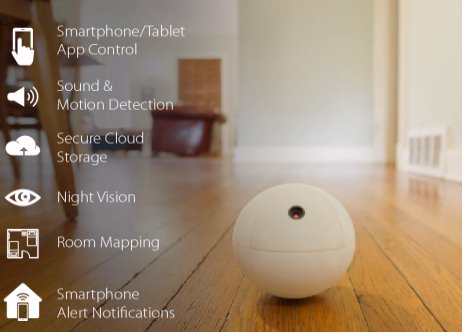
Omar Barlas moved to Dallas, TX, and heard that his apartment complex had been broken into a few months prior. ?I thought I should secure my home,? he says. He wanted full video coverage of all the rooms in his apartment, but didn?t like what he found on the market. ?I went out looking for cameras, but I could not see any single solution that could work for me.?
Setting up multiple, stationary cameras in each room would have cost $3,000 by his estimate, and would have been complicated to install. So he came up with the idea of building his own video camera, one that was attached to a robotic ball and could freely travel from room to room like a Roomba. With that concept, a single camera could do the work of a whole house-full of commercial monitoring equipment.
His project, called Orbii, got an honorable mention at the 2016 CES Innovation Awards and has raised more than $47,000 on Indiegogo since May. As of August, Orbii is still a prototype. The current version can roll around a room and stream live video to a computer, but it is not yet smart enough or connected enough to protect a home. But Barlas will enter production in November and plans on shipping the finished Orbiis to customers in March 2017. He hopes that the more complete prototype will be available to test drive at CTIA Super Mobility conference in Las Vegas in September.
Orbii?s appearance has changed since CES, where it had a BB-8 look to it, because the camera spun wildly as the device rolled across the floor. The new version consists of a stable drive assembly, made of a low-density polycarbonate, and a clear outer shell, made of high-density polycarbonate. (Orbii?s innards stay upright now because the drive assembly is weighted at the bottom.) The final product will have a UV coating on the outside shell to resist scratching and the drive assembly will be available in different colors, which customers can customize when they order.
Inside the drive assembly is a built-in microphone, speaker and detachable HD (720p) camera. The stabilizer bracket has space for four additional attachments, which connect via USB-C ports. These add-ons could include more robust 4K cameras, atmospheric sensors or laser pointers.
Orbii connects to Wi-Fi, runs Linux, and will have its own app. Using the in-app joystick, users can steer Orbii around the home, pan and tilt the camera, control the sensors and watch the live video feed from anywhere in the world. You can also use the microphone and speaker to communicate with whatever?or whomever?you see on the other end. Is there a robber in your kitchen? Yell at him to get out!
When researching home security cameras, Orbii?s creators noticed a flaw in the market ? current cameras are limited in viewing angle, coverage, and most importantly mobility. All of the available offerings require the buyer to purchase multiple cameras to set up all around their home. And so the idea for Orbii was born: a driveable, internet connected camera that a user can drive from room to room for a cost effective home security solution.
While the Orbii was in early development, the team was approached by first responders. They loved the idea behind the Orbii, but were looking more specifically for a remotely controlled environmental monitoring solution for Fire Fighters, Police, and Hazmat teams to use during rescue operations. So the Orbii team designed a modular sphere with interchangeable panels that can be upgraded to include environmental and atmospheric sensors, letting first responders drive it into dangerous sites and obtain situational awareness. This campaign will fund the consumer version, which can later be adapted into a lifesaving commercial version.
Source: indiegogo.com
